Dmytro Andriyevskyi. Architect of the Restoration of Ukraine’s Independence
8/20/2023
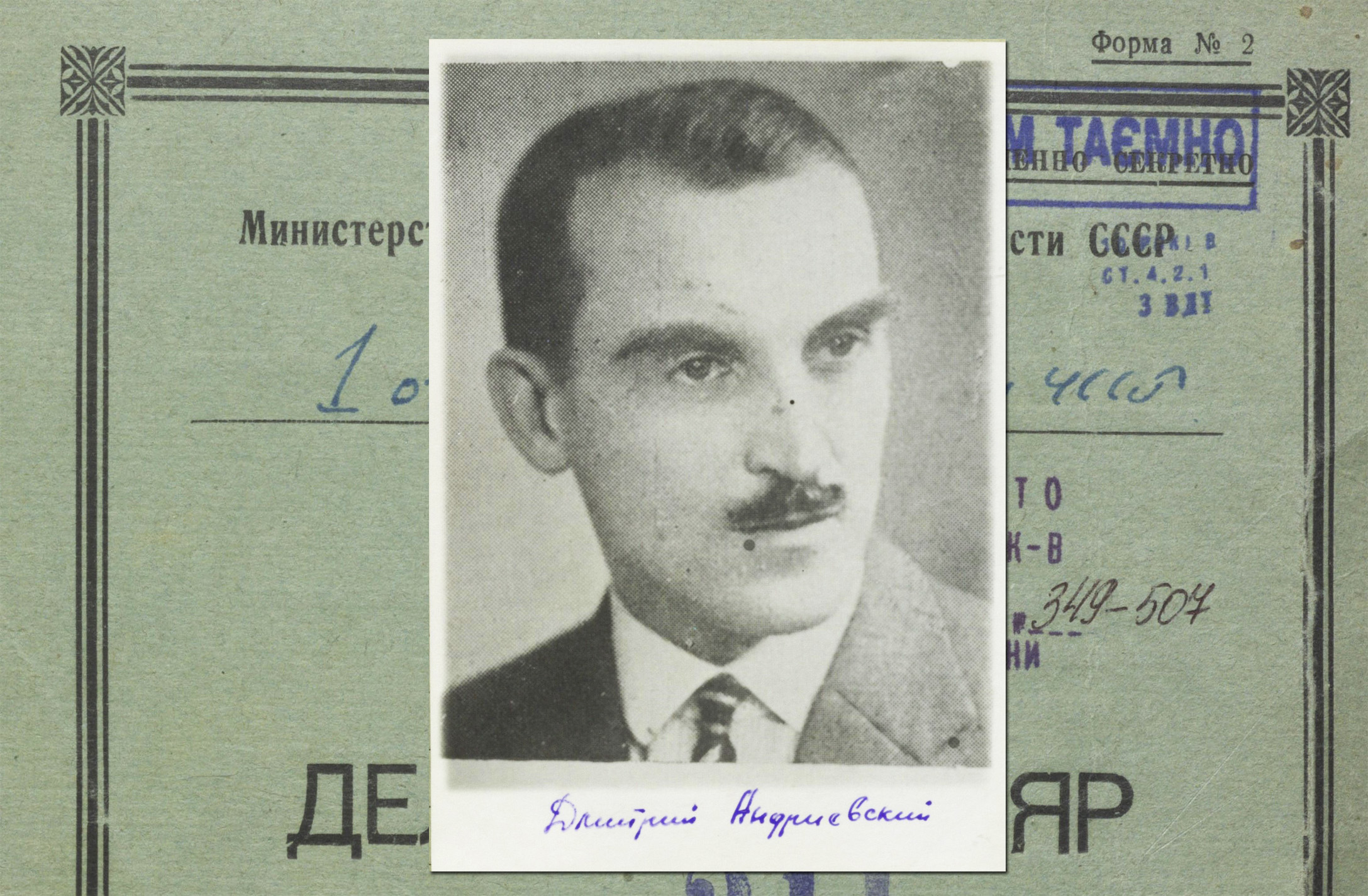
The name of Dmytro Andriyevskyi often appears in the documents of the nkvd/mgb/kgb of the ussr, which relate to the fundamental moments of the creation and activities of the OUN. He is mentioned as one of the main theorists and ideologists of Ukrainian nationalism and the struggle for restoration of Ukraine’s independence. The case file, which was opened in moscow at Lubyanka in 1934, was code-named “Architect”. Now declassified documents from the Branch State Archives of the Foreign Intelligence Service of Ukraine make it possible to find an answer to the question why he was so dangerous for the kremlin authorities.
The Case-File “Architect”
From the case on which worked the foreign department of the main directorate of state security of the nkvd of the ussr, only excerpts have been preserved in the archival funds of the Foreign Intelligence Service of Ukraine. One of them states: “Andriyevskyi is one of the members of the Provid, who has a brilliant official position, works as an engineer-architect in a large construction company. Has absolute trust among Belgian politicians. Has been living in Belgium for 10 years” (BSA of the SZR of Ukraine. – F. 1. Case 10938. – V. 1. –P. 56).
Another excerpt is from the book “Ukrainian Underground” by one of the leading figures of the OUN Volodymyr Martynets, which was made by officers of the nkvd of the Ukrainian ssr. In the book, a separate section is devoted to Dmytro Andriyevskyi. The chekists included in their paper the following defining characteristics written by a fellow in arm in the national liberation struggle: “... A well-read person with a critical mind, inclined to analysis, even more – to synthesis, full of creative ideas... Engineer Andriyevskyi sits deep in Ukrainianness – both in origin and character. He perceives Ukraine wholeheartedly, and his stay abroad in the environment of French culture and civilization really enriched his intellect, but did not touch his “Ukrainian soul”. A man not of “straw fire”, but of “cold fervor”, whom nothing can move from the main positions, who is constantly dissatisfied with what has been achieved and strives for the best, but at the same time does not shy away from daily, “minor” work”.
The reports received as a result of operational work, show that he was born into the family of a clergyman in Poltava region, and “in November 1918, in the city of Bila Tserkva, Kyiv region, he took an active part in an illegal meeting of representatives of the National Union and the Command of the Sich Riflemen, at which it was decided to raise an armed uprising in Ukraine”. Later he worked “in the Petliura Ministry of Foreign Affairs, with which he came to Poland”. In 1919-1920 he worked as part of the UPR diplomatic mission in Sweden, in 1921 – as a UPR Consul in Switzerland. After that, he moved permanently to Belgium. He graduated from the University of the Belgian city of Ghent with a diploma of an engineer-architect. First he worked in France, later – in Belgium in various companies. Among others, the concern Sofina is mentioned.
Therefore, the name of the case was given by the chekists in accordance with D. Andriyevskyi’s specialty. At the same time, according to documents and individual memoirs, he met this definition both in his specialty and in his lifestyle and activity. As a professional architect, he skillfully built fundamental ideological provisions that were supposed to convincingly testify to Ukraine as an independent united independent state. In one of the agent reports, the foreign source “Legist” provides his own characteristics and perceptions of D. Andriyevskyi, which complement the already known biographical information. In particular, the agent points out the following:
“... Until 1928, D. Andriyevskyi was an ardent UPRist (Petliurite), was close to Shulhyn, Matsiyevych, Slovinskyi and other Petliura aces, collaborated with the Petliura “Tryzub” (“Trident”- Transl.) and other bodies of the UPR, but from 1928 began to change his orientation. Petro Kozhevnikov, who knew Andriyevskyi from Kyiv and the “student kurin” well, met him in Brussels during the Congress (of International Union of Students) and brought him together with E. Konovalets, V. Martynets and Riko-Yaryi. They appreciated Andriyevskyi's abilities and connections and managed to bring him to their side. Andriyevskyi became a nationalist and began collaborating with the then emerging “Nation Building” (in Prague).
According to V. Martynets, at first Andriyevskyi was not an “orthodox nationalist” and always tried to unite nationalists with Petliurites, but at the beginning of 1929 he had already completely “got nationalized”. In February 1929 he was already a member of the Vienna Congress of Nationalists and after the “Congress” – a member of the Provid of UN, “ideological referent”. This “ideological” function of his in the PUN is explained by the fact that, in addition to his engineering, Andriyevskyi was intensively engaged in philosophy and his knowledge was much higher than that of other OUN “philosophers-ideologues” – D. Demchuk, Vassiyan, O. Boydunyk and V. Martynets” (BSA of the SZR of Ukraine. – F. 1. Case 10938. – V. 1. – P. 168).
Other sources say that D. Andriyevskyi was elected to the Provid of Ukrainian Nationalists in November 1927 and did a lot of organizational work to convene the First Congress. He was the author of a number of journalistic articles, in which he outlined the basic principles of the ideology of nationalism and ways to restore Ukraine's independence – “Our Position”, “The Way of Development” and others. And before that, the journal “Tryzub” founded by S. Petliura regularly published analytical, ideological and theoretical articles aimed at finding new ways to build the Ukrainian nation as an integrity that stands above the personal ambitions of leaders, classes or strata.
In those articles, he stressed that nation-building should begin with overcoming slave psychology in own souls and instilling in Ukrainians a sense of self-esteem, dignity and solidarity. He assumed the integrity and solidity of the Ukrainian community and pointed out that all forces of Ukrainian patriots should be directed to achieve this goal. The Ukrainian national idea, he believed, is not limited to ethnic territory and is not limited to ethnic content. It is formed on the basis of a historical mission of Ukraine which is located between the European West and the Asian East, and is the natural defender of peoples threatened by aggressive muscovy.
D. Andriyevskyi did not cease to repeat that the development of the Ukrainian nation requires its own state, and only being a nation-state, Ukraine will become a world power to be reckoned with by its neighbors.
According to archival documents, D. Andriyevskyi was engaged not only in ideology and theoretical developments. In the 1930s, he was a political referent of the Provid of Ukrainian Nationalists, took care of organizational affairs related to the activities of the OUN abroad, promoted the Ukrainian cause in the world, and also made many efforts to unite Ukrainian state-building trends. At his initiative, a meeting of representatives of Ukrainian organizations in exile was held in Belgium in 1931 and the European Association of Ukrainian Organizations Abroad was founded. Besides, he made a months-long visit to the United States, where he met with representatives of Ukrainian emigration and influential politicians. Reports on this settled in the case-file on him.
An Attempt to Influence Through Brothers
Traditionally, within the framework of intelligence cultivation, the chekists collected information about close relatives, through whom they could obtain more information about the main defendant in the case or influence him in the “right” direction.
Therefore, inquiries began to be sent to Poltava to the place of birth with a request to collect as complete information as possible about his parents, brothers, sisters, acquaintances who could maintain written contacts with him. As it turned out, the family consisted of a father, a clergyman, a mother, four sons and a daughter. Dmytro was the eldest son. His father, Yuriy Andriyevskyi, died in 1919 in the village of Popivka in the then Khorol district of Kharkiv region. At one time, the whole family moved there from the village of Bodakva, Lokhvytsia district.
At the time of the verification, the mother lived with her son Feodosiy in the town of Kolomak, Kharkiv region. Feodosiy worked as an agronomist at the district land department, was non-partisan. Soon he moved to Sumy, where on June 24, 1941 he was arrested by the nkvd. His further fate and reason for the arrest are not known.
Brother Ivan, having graduated from the Kyiv Cooperative Institute, left for the city of Zaporizhzhia. There he first worked as an agronomist-economist, soon – as a lecturer and geography teacher at a music college. He was nonpartisan and single. He was immediately taken into operational study. He was offered to join the ranks of the red army, but he refused. During the conversations, as noted in the papers, “he tried to emphasize his loyalty to the soviet government, but the impression from him remained negative, cunning”. checkists could not persuade him to cooperate. In June 1938 he was arrested by the Zaporizhzhia city department of the nkvd for anti-soviet activities and sentenced to death. Probably, as a close relative of the “enemy of the people”.
Brother Borys was a famous surgeon in Kharkiv, Professor, Doctor of Medical Sciences, head of the Chair at the Kharkiv Medical Institute of Post- Graduate Education. The chekists cased him as a close acquaintance of another Professor at the Kharkiv Medical Institute with the surname Roze, who was repressed in 1937. In 1940, Borys was transferred to work in Dnipropetrovsk, where they continued to monitor him. Archival documents show that he took an active part in the nationalist movement. But there was no information about correspondence with his brother Dmytro, or about other contacts. With this in mind, they did not trust him and did not dare to establish a trusting relationship with him in order to start any operational game with him abroad.
Later in the case file there was information that in 1944 he fled to the West and settled in Munich, where he continued his medical practice and not only. It is mentioned that in early 1945, the wounded Yaroslav Stetsko was brought to Munich. He allegedly was returning from Vienna to Bavaria, got under fire in Western Bohemia and was wounded by explosive bullets in his arm, leg and abdomen. He was successfully operated on by Borys Andriyevskyi.
Without reference to this case, it is reported that Borys “took an active part in the activities of the foreign center of OUN-Banderites, personally connected with Stepan Bandera. In 1947 he participated in the Conference of the Central Provid of the OUN-Banderites, was elected Deputy Chairman of the Presidium of the Conference”, as well as that he held other positions in public organizations abroad (BSA of the SZR of Ukraine. – F. 1. Case 10938. – V. 1. –P. 137–138).
Sister Vera lived in the Donbas near the city of Stalino. Together with her husband Ivan Kozlovskyi, she worked at the post office and they were not of particular interest to the chekists.
“Artist” Versus “Architect”
Having studied close relatives, the chekists realized that for further operational cultivation it was necessary to look for the right people surrounding D. Andriyevskyi not in Ukraine, but abroad. Besides, to single out those who could make him interested, be useful in certain matters. These were supposed to be brought to him under a certain legend. And such a person was soon found.
Helpful was the information that D. Andriyevskyi had a talent for art and literature, helped to organize exhibitions of Ukrainian artists’ works in Belgium, wrote for scientific and literary journals. It was found out that when artists Andriy Taran, Vasyl Sedliar and Mykhailo Boichuk arrived in Paris from Ukraine, they purposefully traveled to Brussels to meet him. He also participated in organizing exhibitions of Kyiv and Kharkiv artists in Antwerp and Brussels. One of the archival documents states that in 1934 about a hundred paintings by Ukrainian artists from that exhibition were housed at D. Andriyevskyi’s.
Employees of the foreign residentura of the nkvd of the ussr began to carefully study his contacts in the artistic environment and found among others the artist Mykola Hlushchenko. At that time, in 1935, M. Hlushchenko had been cooperating with the Paris residentura of the soviet intelligence for several years. A case called “Artist” was opened on him. First he signed his agent messages with this codename, later – with “Yarema”. After completing a number of tasks, he was allowed to return from emigration to his homeland. He did not hide the information that he was going to go with his family to the ussr. The residentura decided to use the time remaining before his departure to obtain from him additional information about representatives of emigration who were of interest to soviet intelligence and with whom he met in France and other countries.
It turned out that he had known D. Andriyevskyi since the mid-1920s. They last saw each other in Paris in 1929. Since then, they periodically corresponded. The next meeting was planned carefully. In order not to arouse any suspicions, the purpose of the trip was chosen to visit the World Brussels Exhibition. In a telephone conversation, M. Hlushchenko informed D. Andriyevskyi that he was going to the exhibition and was invited to visit.
Their meeting took place on May 13, 1935. In a message about it, the “Artist” pointed out that D. Andriyevskyi was glad to see him, that he lived modestly, renting a room from his friends. He asked about the life of Ukrainian artists in Paris, about the planned leaving for the ussr. At the end of the meeting, he asked if they could correspond. Hlushchenko replied that it would be risky for him to receive letters from a Ukrainian émigré, known as an enemy of the soviet union, and that this could harm him. Then D. Andriyevskyi suggested writing to his Belgian acquaintance, “a good friend of Ukraine”, saying that this would not fall under suspicion. He asked to inform about artistic life in Ukraine. They agreed to meet again in Paris or Brussels before leaving, if possible.
M. Hlushchenko reported on his impressions from the meeting with D. Andriyevskyi that he was an incorrigible fanatic and that he spoke with fierce hatred about the communist leaders of soviet Ukraine Postyshev, Kosior and Balytskyi. But then, they themselves knew about this in the residentura. It was more important to consolidate the contact and develop it for the future. The report from Paris to moscow read as follows: “Andriyevskyi's proposal to the “Artist” to correspond with him through a figurehead (student Leonardo) deserves special attention. We believe that Andriyevskyi made a direct offer to the “Artist” to be his agent in Ukraine” (BSA of the SZR of Ukraine. – F. 1. Case 10938. – V. 1. –P. 90).
The instructions from moscow set the task of deepening the cultivation. To this end, they instructed to wait for D. Andriyevskyi’s arrival in Paris. He spoke about such plans. If this does not happen, to organize M. Hlushchenko’s staying in Brussels on the way to the ussr. There was an acceptable reason for this – his wife's brother lived in that city.
“We will not build legends through “Artist” for “Architect”, – reads the instruction, – because we abandoned this method of work. It is not in our interest to turn “Artist” into “Architect”’s agent and supply him with information. The essence of this development should be that “Architect” directs “Artist” through his connections in the Ukrainian ssr. Future meetings of “Artist” in the Ukrainian ssr with people who will come from abroad with assignments from “Architect” are also of interest. For example, with Leonardo. Therefore, “Artist” should only get along with “Architect” and achieve positive results” (BSA of the SZR of Ukraine. – F. 1. Case 10938. – V. 1. –P. 80).
That is, of great interest for the nkvd were D. Andriyevskyi's connections on the territory of the Ukrainian ssr and couriers whom he could send to perform certain tasks. Further instructions from moscow still recommend not to send M. Hlushchenko to him anymore, so that this would not alarm. “In the future”, it was noted, “Artist” may be sent to Andriyevskyi from the ussr, after preliminary correspondence with him, for his cultivation or recruitment” (BSA of the SZR of Ukraine. – F. 1. Case 10938. – V. 1. –P. 89).
The nkvd will return to this issue in a few years. And before M. Hlushchenko's departure, correspondence will continue. In one of those letters, D. Andriyevskyi tried to sincerely give friendly advice on how to behave in the ussr in order to avoid problems with the stalinist regime and not to fall under the millstones of repression, as happened with tens of thousands of representatives of the Ukrainian intelligentsia. He stressed that it was worth positioning oneself as a person outside politics. “In my opinion”, he wrote, “your organic apoliticism is your life saver, that is, resolving possible difficulties... In any case, you have to be careful, cunning like a fox and wise like a snake. Only in confrontation with real facts will it be possible to find a twist and ways of adaptation” (BSA of the SZR of Ukraine. – F. 1. Case 10938. – V. 1. –P. 93).
Put on the Wanted List No. 1
The nkvd tried to obtain information on D. Andriyevskyi from different sources. In particular, among the archival documents there are reports of Vasyl Khomiak, known as the agent “Lebed” and “82”. In 1933, the chekists arranged his being employed as a sailor on a soviet cargo ship, on which he soon arrived in Belgium. He had the task of finding a member of the OUN Leadership D. Andriyevskyi and tell him, according to a well-established legend, about how he was engaged in underground work, about the difficult situation in Ukraine, famine, repressions, arrests of Galicians, the danger that he, as a former senior officer of the Sich Riflemen, could be arrested. Like, this was the reason for the escape.
Having returned to the ussr, V. Khomiak reported on all this in detail – about the first meeting with D. Andriyevskyi, and then with other leading figures of the OUN and, finally, with Y. Konovalets. But in that situation, the nkvd was focused not on D. Andriyevskyi, but on the leader of the OUN. After the murder of E. Konovalets, they more actively took up the operational cultivation of those who began to take the highest positions in the national liberation movement.
As a result, they received information that D. Andriyevskyi, who at one time could already under certain circumstances get the post of head of the Provid of Ukrainian Nationalists, became close to the new leader of the OUN, Colonel A. Melnyk and began to play a great role in the Organization. As a result of the split of the OUN in 1940, he remained among A. Melnyk's supporters. In the leadership of the OUN(M), as before, he engaged in foreign policy and ideology. He tried in every possible way to popularize the Ukrainian liberation cause, to draw the attention of the world community to it. In his work “Ukrainian Propaganda Abroad” he outlined the basic principles of the OUN's foreign policy, argued the importance of such activities in the struggle for Ukraine's independence.
There is little information about his life and activities during the Second World War in the available archival documents. One report states that after the occupation of Belgium in 1940, he allegedly spoke negatively about Hitler's Germany and its policies. Open research mentions that at the end of 1941 he visited Berlin, where he met with Colonel A. Melnyk. After that, he had to leave for Ukrainian lands, but only reached Lviv. There he was detained by the German police, sent to Berlin, arrested and from January 21, 1942 to October 18, 1944 was in the German concentration camp Sachsenhausen.
One of the documents, which is stored in the archival funds of the Intelligence, provides information that after the Gestapo arrested A. Melnyk in early 1944, D. Andriyevskyi was immediately taken into custody. That is, there may have been some period of liberation from the concentration camp and stay at large. Together with other OUN activists, he was sent to a camp in Bretz, where imprisoned nationalists were accused of spreading anti-German propaganda and attempting to create an independent Ukrainian state within the then Third Reich. Besides, there is a mention that he was also held in the Oranienburg concentration camp.
Despite some discrepancies, the available information shows that that period was quite difficult in the life and work of D. Andriyevskyi. Before the end of the war, he was released, together with A. Melnyk left Berlin for Weimar, then – for Bad Kissingen. After Germany’s capitulation, he returned to Belgium.
In 1948, the ministry of state security of the ussr declared D. Andriyevskyi wanted under list No. 1 of “dangerous state criminals, subject to immediate arrest”, and more purposefully began to collect dossier on him. In the same year, the Ukrainian National Council (UNRada) was created in Bavaria, which soon became the basis of the reorganized State Center of the Ukrainian People's Republic in exile. D. Andriyevskyi was elected a member of the UNRada and its executive body. He tried to use this rostrum to unite Ukrainians in the struggle for the restoration of Ukrainian statehood.
Over time, the mgb’s operational capacity to gather information about D. Andriyevskyi decreased. It wasn't until July 1959 that an opportunity arose unexpectedly. At that moment a group of Ukrainian tourists who were on a cruise around Europe on a ship visited Brussels with an excursion. It usually included a kgb officer. In one of the museums they accidentally met D. Andriyevskyi. He approached the tourists when he heard the Ukrainian language.
Immediately, a kgb officer turned up and asked the man who he was. “I'm Dmytro Andriyevskyi, an old émigré from Ukraine”, he said. “In that case, we know you. You are the Minister of Foreign Affairs of the UNRada”. The stranger’s words alerted D. Andriyevskyi. He immediately explained that recently many emigrants have been returning to Ukraine, who allegedly spread news about the life of the Ukrainian community abroad on the pages of newspapers.
The kgb officer took over the further initiative in the conversation. Then he invited Andriyevskyi to a lunch at a restaurant and a walk around the city. At this, he asked the correspondent of the newspaper “stalinskoye plemia”, who was part of the group, to take several photographs. Thus, the kgb received fresh photos of D. Andriyevskyi in a hat, as well as a number of newspaper clippings that he brought to the second meeting and the address of his residence in Brussels written on the envelope by him. This was done at the request of the officer. He promised in return to hand over Ukrainian books and newspapers through someone.
“Taking into consideration the fact that Andriyevskyi is one of the ideologists and the most active leaders of the OUN-Melnykites”, the report from kyiv to moscow said, “the KGB of Ukraine considers it expedient to consolidate the initial contact established with him by the officer and give him the promised Ukrainian literature (2-3 books of fiction, brochures on the growth of material well-being of the Ukrainian people, organization of education, etc.)... In the process of meetings with Andriyevskyi, it will be possible to study more deeply his views, features of his personality, plans for the future and use this to gradually lead him away from active anti-soviet activities” (BSA of the SZR of Ukraine. – F. 1. Case 10938. – V. 2. –P. 34).
Soon this operational plan was continued. The kgb remembered that the brother of Mykola Hlushchenko's wife lived in Brussels. In October 1961, she was just about to go to visit him. Through her, they decided to hand over literature and a letter, which M. Hlushchenko personally wrote. In the letter, the artist was interested in many issues and invited his old acquaintance to come to moscow for the decade of Ukrainian art. But the meeting in Brussels did not happen. The wife of “Artist” tried to find D. Andriyevskyi to no avail. At the address written by him on the envelope, she was told that he did live there once for a short time, but they did not know where he had moved. Searches through telephone directories did not give the desired result either.
Therefore, in March 1963, after unsuccessful attempts to develop contact with D. Andriyevskyi, the kgb came to the following conclusion: “Now there are no real opportunities to study Andriyevskyi. It is advisable at a favorable time to use the case materials in measures to compromise Andriyevskyi” (BSA of the SZR of Ukraine. – F. 1. Case 10938. – V. 2. –P. 75). This was the continuation of not only this, but also of the vast majority of other operational cases concerning active figures of the Ukrainian national liberation movement, who could not be persuaded to change sides and abandon their ideas, views, beliefs and intentions to fight for the restoration of Ukraine's independence.
D. Andriyevskyi to his last day did not cease to consider moscow guilty of all the problems and troubles of Ukraine. In one of his early letters dated 1936, which is kept in the archives of the Intelligence, he pointed out: “It should be obvious to us and to foreigners that for Ukraine the main and most terrible enemy is moscow. And from this point of view, we are considering the issue of our western borders. First of all, we must deal with moscow, and here we are going the same way with both the Germans and the Poles. Together with them, we want to take part in the separation of two worlds: Eastern – moscow-Asian and Western. Ukraine geographically, historically and psychologically belongs to the second...” (BSA of the SZR of Ukraine. – F. 1. Case 10938. – V. 1. –P. 11).
D. Andriyevskyi predicted the collapse of the ussr. “The future of the soviet empire”, he wrote in one of his works in 1958, “is written in its very nature, in its internal content, in its construction. From the beginning of its existence, it has been full of contradictions that tear it apart and from which it will one day perish, decompose, disintegrate”.

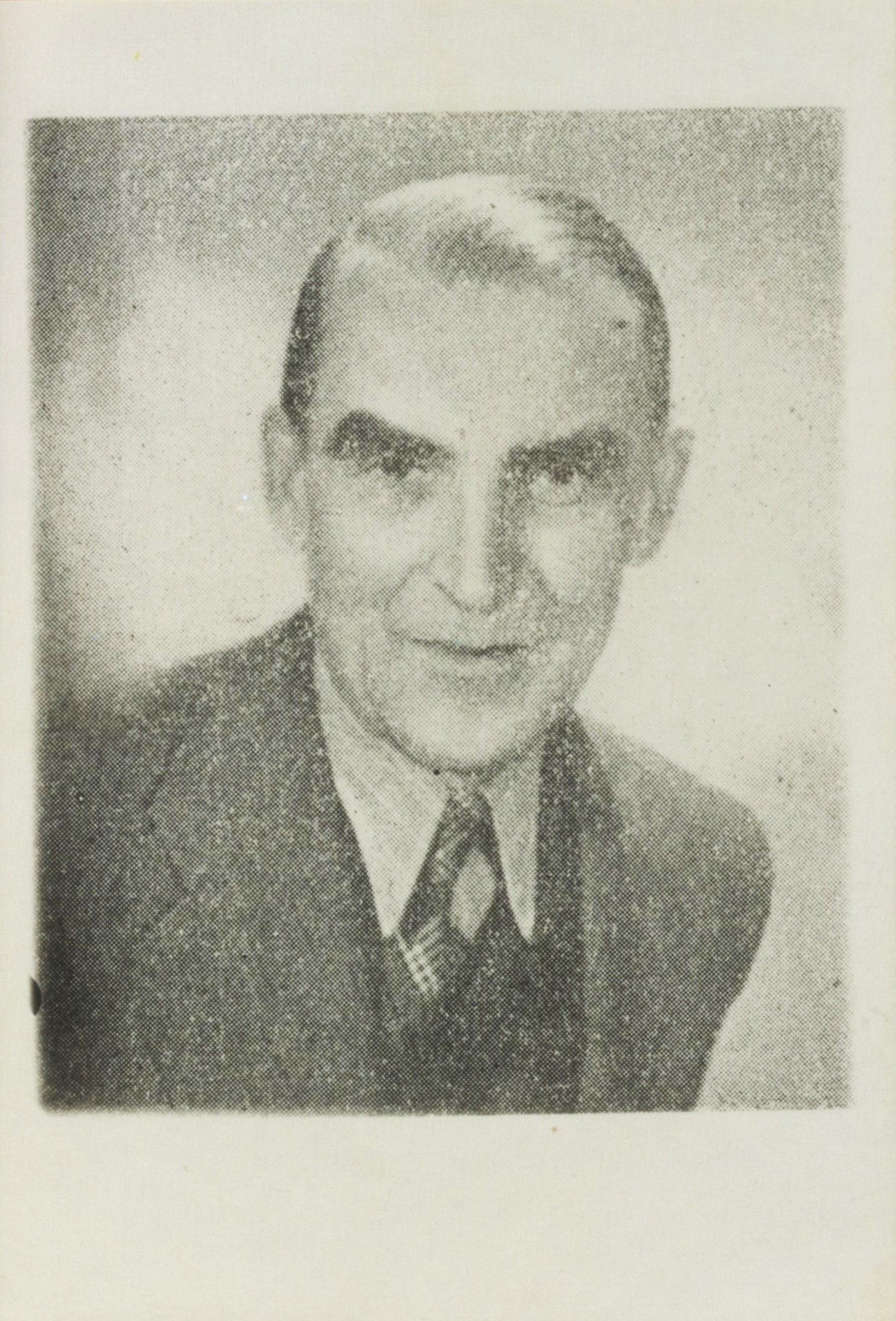
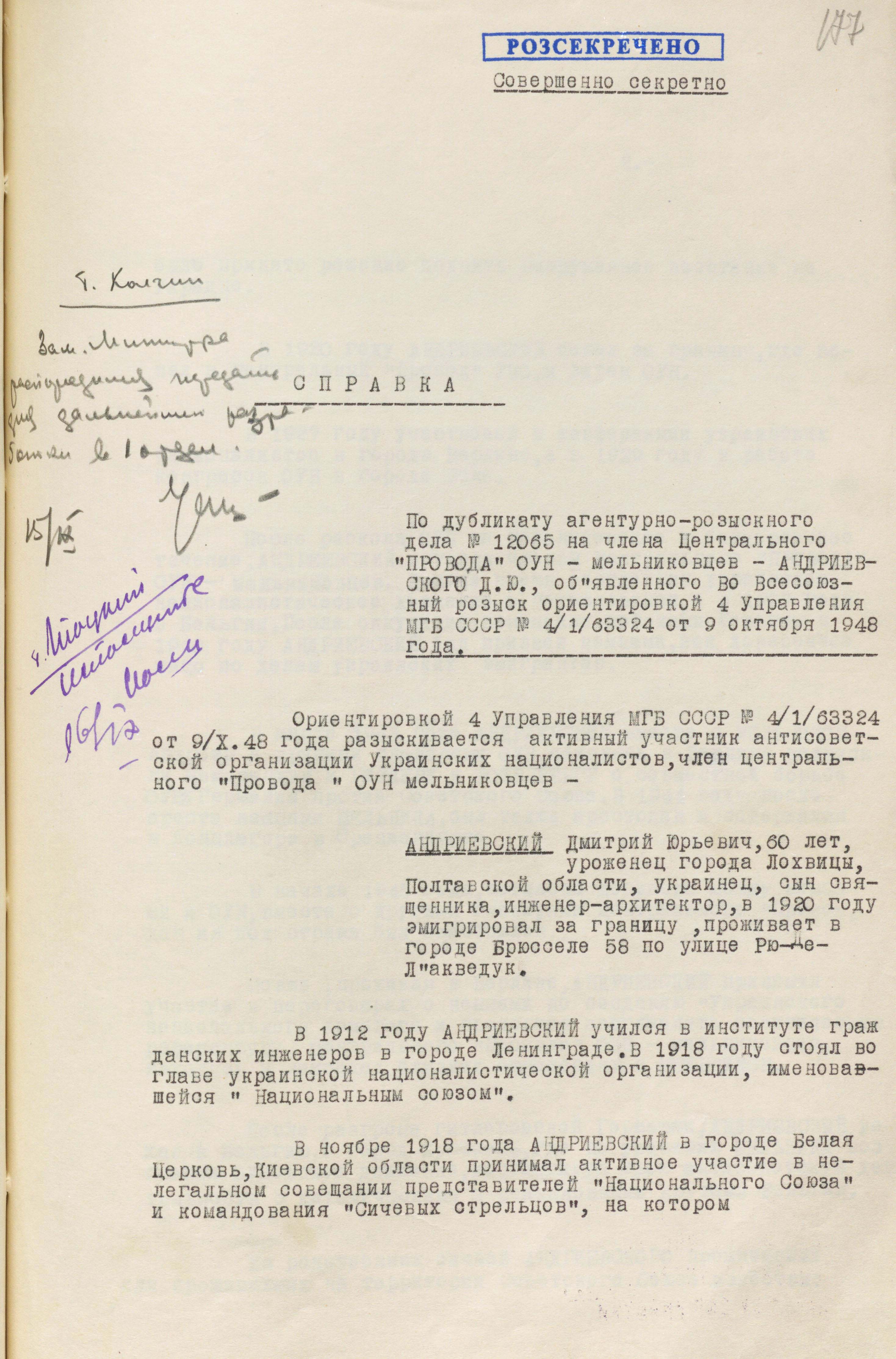
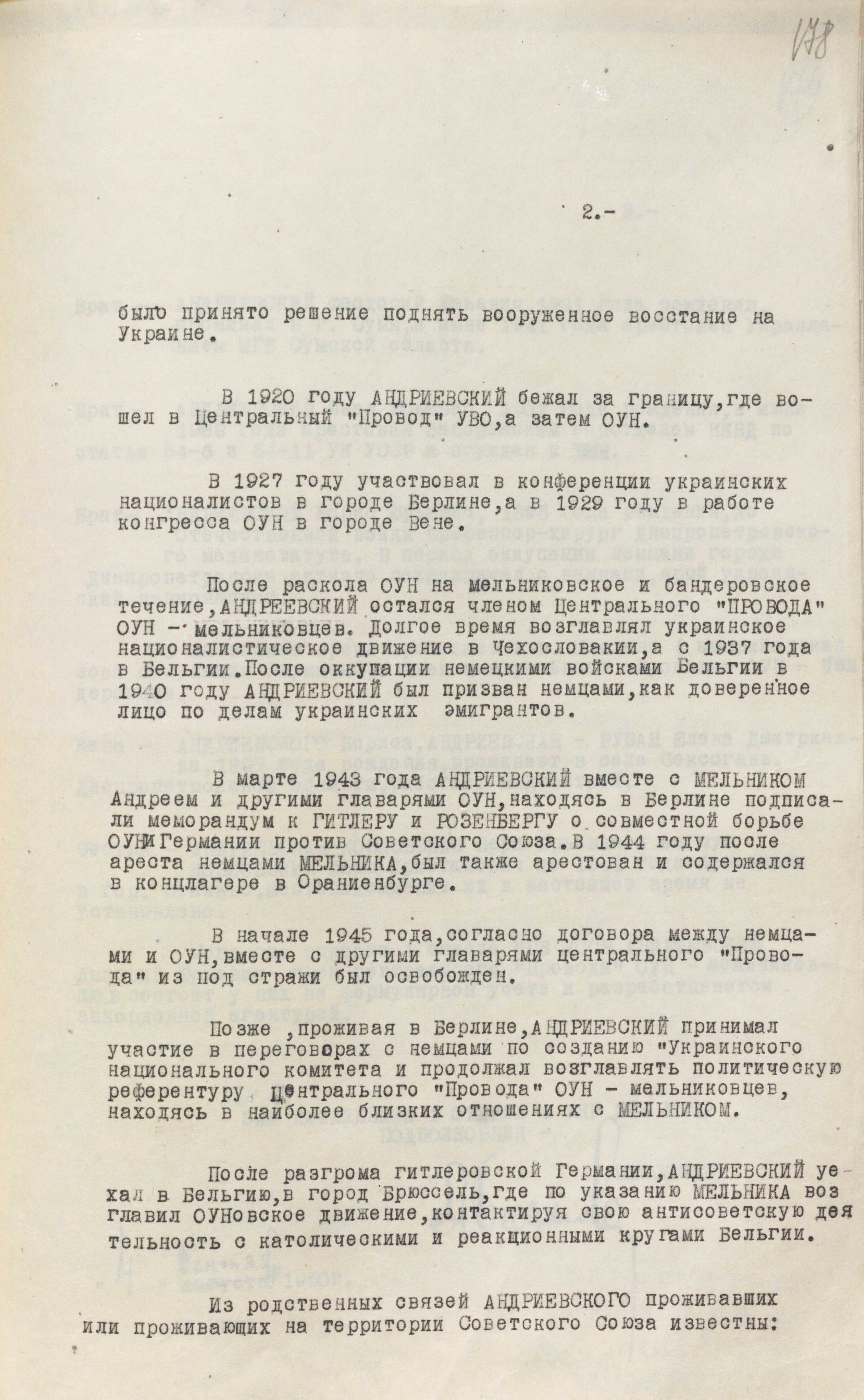

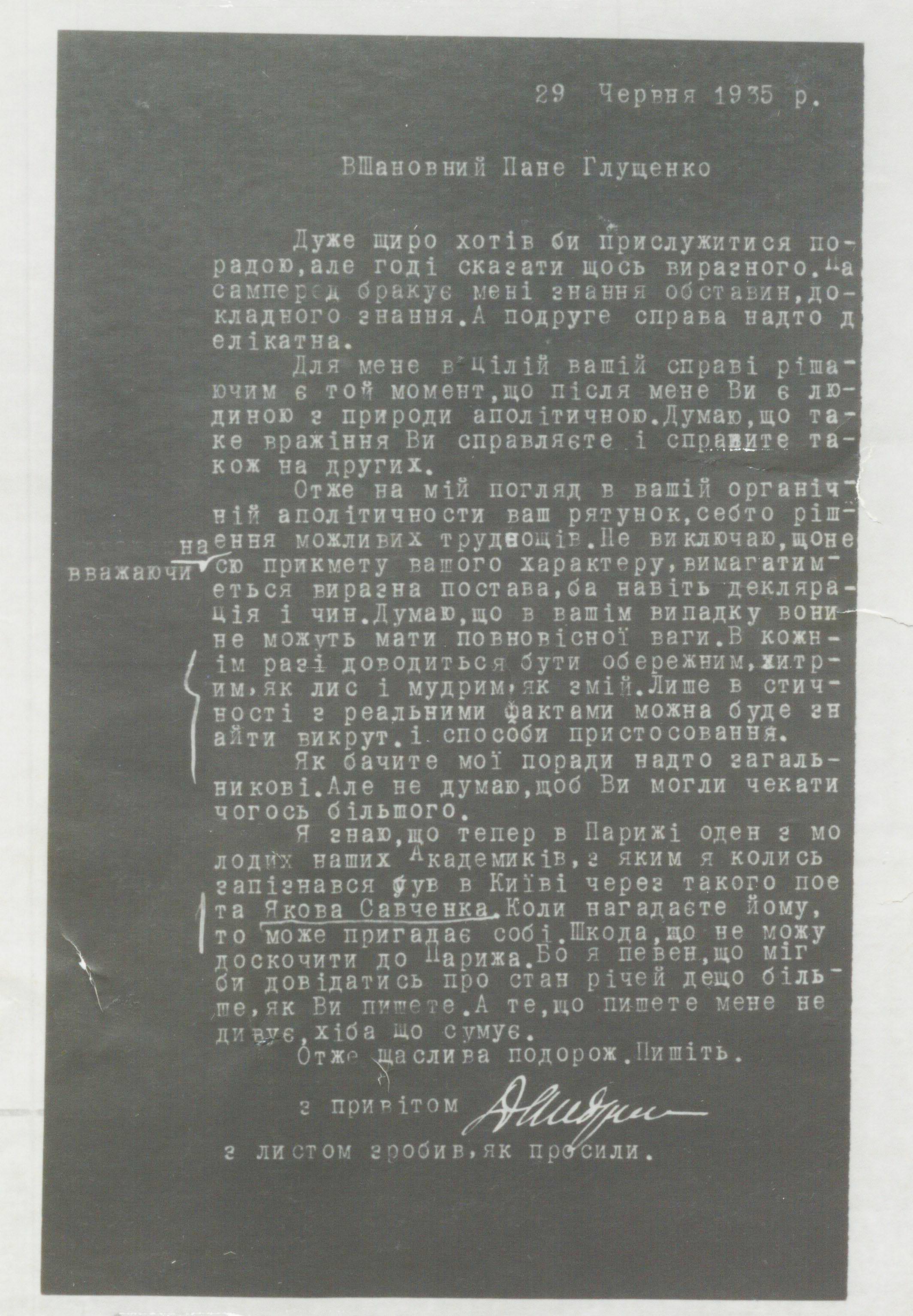
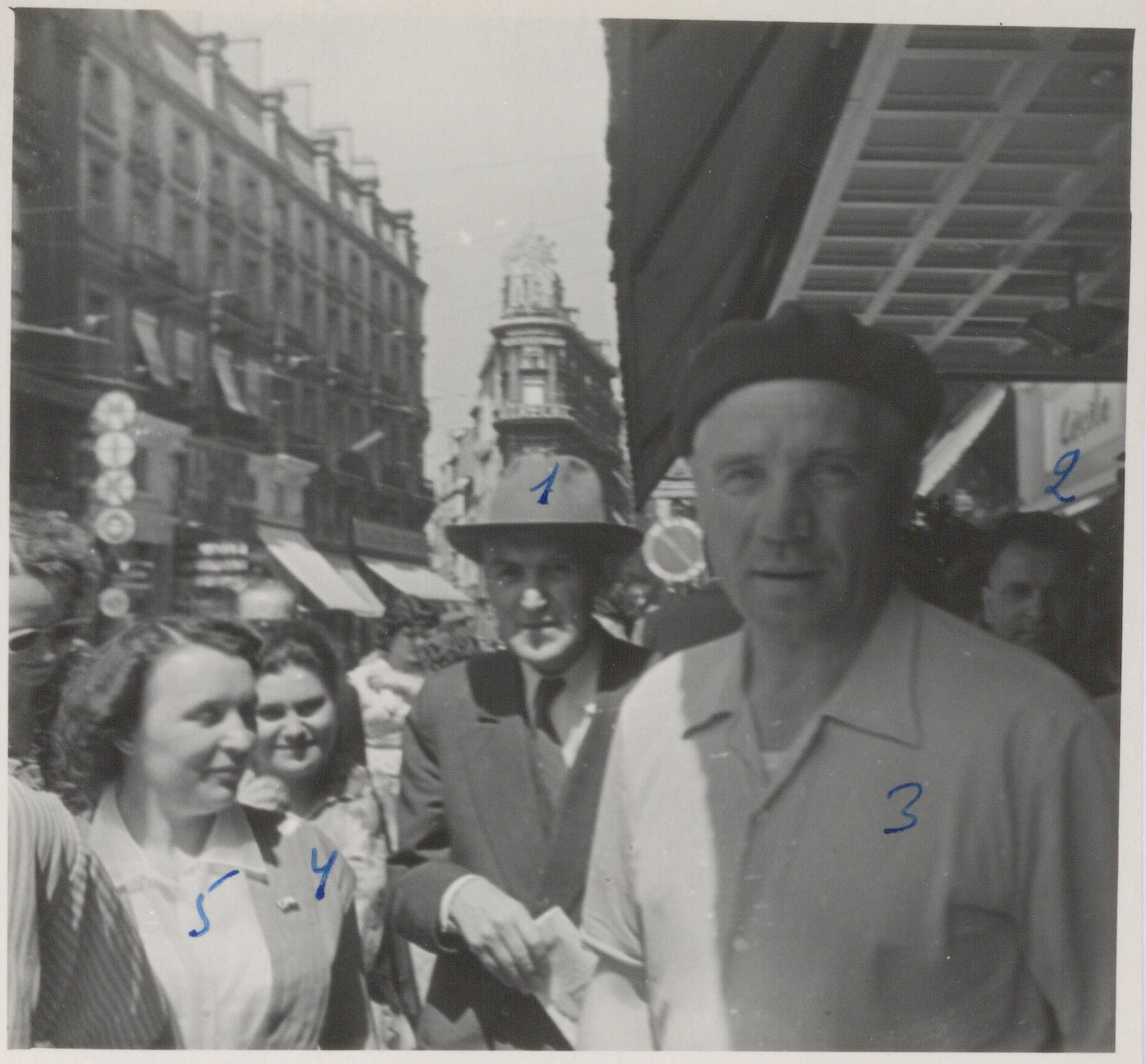
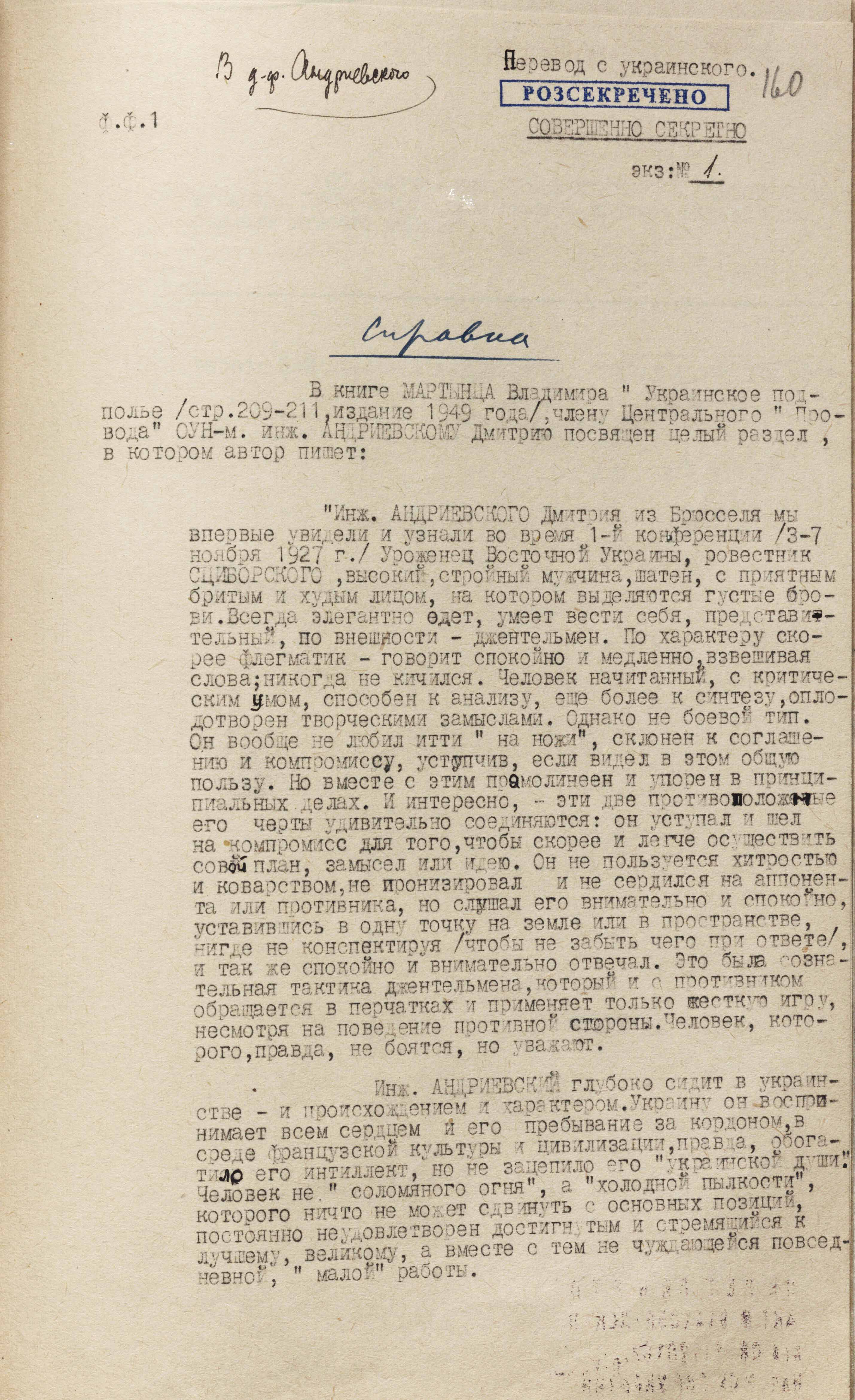
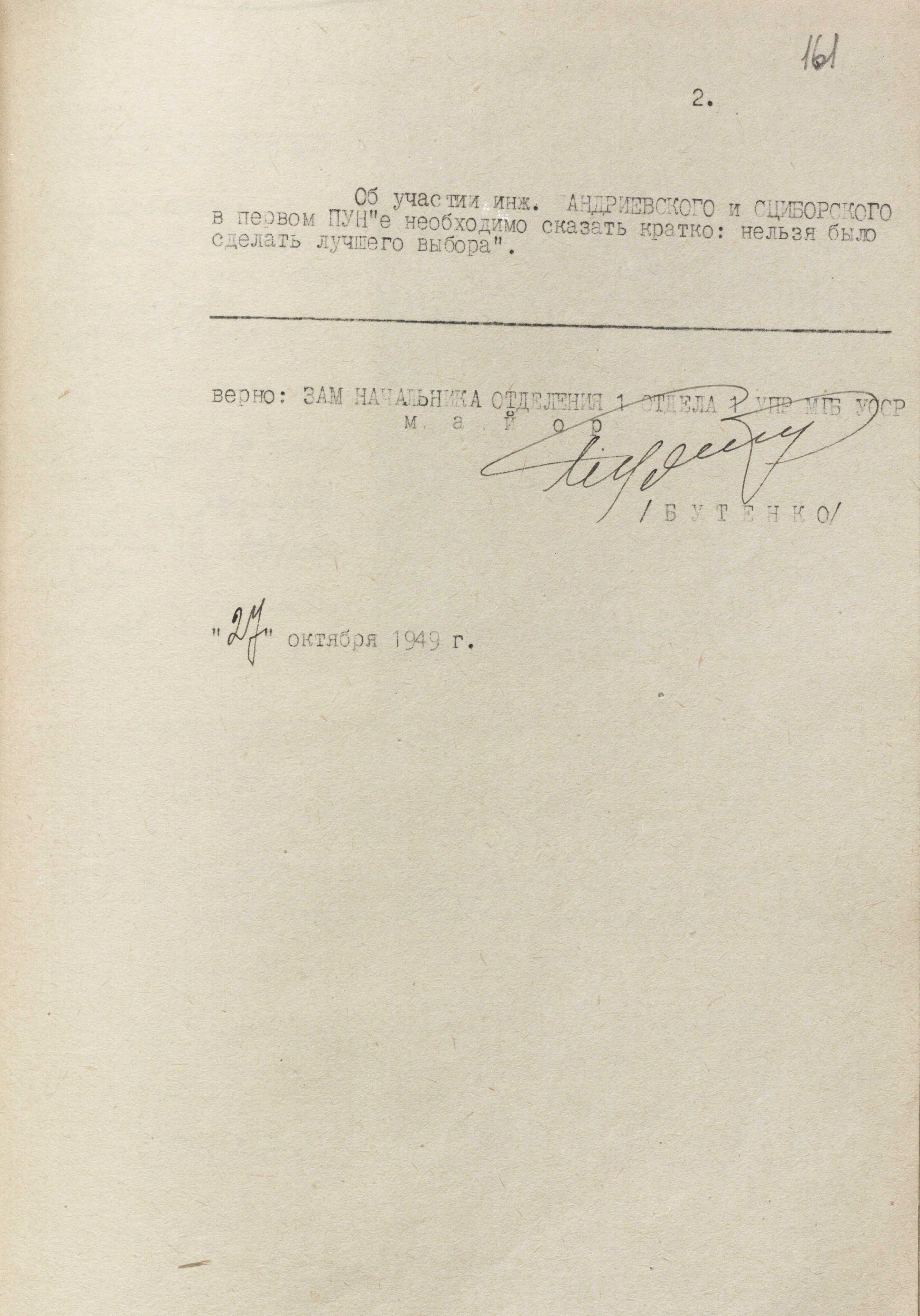
.
